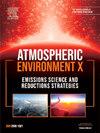Verification of fossil CO2 emissions from Swiss cement factories using direct and indirect 14CO2 measurements
IF 3.4
Q2 ENVIRONMENTAL SCIENCES
引用次数: 0
Abstract
Cement production currently emits approximately 8 % of global CO2. However, the fossil content of these emissions can vary significantly due to methods used to reduce fossil emissions, such as the increased use of alternative fuels. Here, we investigated three CO2 sampling methods used to analyse 14CO2 and estimate the fossil fraction (in terms of F14C) of emissions from three Swiss cement factories. First, direct stack exhaust gas sampling was conducted at a main study site over 6 months and 14CO2 measurements were compared with 14C values from producer fuel use data. A positive offset in F14C was observed with theoretical values compared to the measurements. This could be reduced by adjusting the assumed 14C content of some fuels, particularly shredded wood waste. Second, repeated downwind CO2 emission plume sampling campaigns were carried out at all sites, allowing for a remote estimation and comparison of their F14C signatures. These measurements yielded realistic average values but also demonstrated sensitivity to local wind conditions, i.e. wind speed and direction. Lastly, we analysed the bulk 14C content of tree leaves collected around each site to assess their long-term atmospheric fossil CO2 exposure. Although the observed 14C depletion and fossil fraction were generally small (close to uncertainty ranges), trees near the factories consistently showed lower F14C values than background trees. Direct stack exhaust gas sampling proved to be the most reliable approach for quantifying fossil CO2 emissions from cement production. Crucially, adjustments made to fuel 14C contents to match measurements suggested an underestimation of fossil CO2 emissions from the producer at our main site by more than 2 %.

使用直接和间接的二氧化碳测量方法验证瑞士水泥厂的化石二氧化碳排放量
水泥生产目前排放的二氧化碳约占全球的8%。然而,由于采用了减少化石排放的方法,例如增加替代燃料的使用,这些排放的化石含量可能会有很大差异。在这里,我们研究了三种二氧化碳采样方法,用于分析14CO2并估计三家瑞士水泥厂排放的化石组分(按F14C计算)。首先,在一个主要研究地点进行了为期6个月的直接烟囱废气采样,并将14CO2测量值与生产商燃料使用数据中的14C值进行了比较。与测量值相比,F14C的理论值为正偏移。这可以通过调整一些燃料,特别是碎木材废料中假定的14C含量来减少。其次,在所有站点重复进行顺风CO2排放羽流采样活动,允许远程估计和比较其F14C特征。这些测量得到了真实的平均值,但也显示了对当地风况的敏感性,即风速和风向。最后,我们分析了每个地点周围收集的树叶的总体14C含量,以评估它们长期暴露于大气中的化石二氧化碳。虽然观测到的14C损耗和化石组分通常很小(接近不确定范围),但工厂附近的树木始终显示出比背景树木更低的F14C值。事实证明,直接烟囱废气取样是量化水泥生产过程中化石二氧化碳排放量的最可靠方法。至关重要的是,对燃料14C含量进行的调整与测量结果相匹配,表明在我们的主要地点,生产商的化石二氧化碳排放量低估了2%以上。
本文章由计算机程序翻译,如有差异,请以英文原文为准。
求助全文
约1分钟内获得全文
求助全文
来源期刊

Atmospheric Environment: X
Environmental Science-Environmental Science (all)
CiteScore
8.00
自引率
0.00%
发文量
47
审稿时长
12 weeks
 求助内容:
求助内容: 应助结果提醒方式:
应助结果提醒方式:


